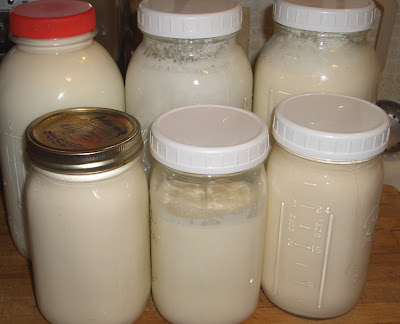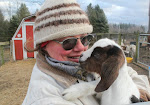 I’m probably breaking all sorts of copyright laws by posting this article from December issue of Gourmet Magazine's article written by Barry Eastabrook about Kobe beef. While I normally post happenings on the farm, I wanted to share this article, along with my comments. Enjoy!
I’m probably breaking all sorts of copyright laws by posting this article from December issue of Gourmet Magazine's article written by Barry Eastabrook about Kobe beef. While I normally post happenings on the farm, I wanted to share this article, along with my comments. Enjoy! Politics of the Plate
Raising the Steaks
By Barry Eastabrook
You have probably heard all the stories about the lush life that results in tender, buttery-rich Kobe beef. Just be glad you haven’t seen it.
I first tasted Kobe beef at the Kobe Club, a sleep midtown Manhattan temple to the legendary steak. Overhead, 2,000 samurai swords hung, business ends downward, from the ceiling, while black-clad staff almost seemed to float through the darkness like shadows. Just after Jude Law and Michael Caine sat down a couple of tables over, a waiter materialized to my left and, with a flourish, presented me with a sizzling ten-ounce rib eye. There was a tiny paper Japanese flag jutting from a toothpick that had been jabbed into the $175 entrée.
I had put a morsel in my mouth, and my surroundings became unimportant. A thin, salty sear on the outside crackled and then released a warm gush of what seemed like beefy, buttery pudding, as rich as foie gras. With that one bite, I understood why Kobe beef has become the signature dish of the decade, with sales tripling during the past five years, not only at urban trendsetters but also with virtually every self-respecting steak house in the country and even at ambitious mid-range grills, where Kobe burgers are the new luncheon item du jour.
As the meat melted in my mouth, I marveled. The night before, I’d grilled a grass-finished skirt steak. How could two cuts of beef be so utterly different, the one pale and pink requiring neither knife or teeth, the other from an animal that had spent its life grazing on pasture as a cow is supposed to do—tangy, chewy, and bloody?
Like many people, I am familiar with Kobe lore: These supremely pampered bovines pass their days in almost Zen-like bliss, getting regular massages and subsisting on all the grain they can eat, washed down with cold Kirin beer. “Imagine a life so completely free of stress, with as much tender-loving-care you could ever want” is how the website of an American importer of Kobe beef puts it. “Sounds too good to be true?”
That was an interesting question, and I wondered why I’d never thought to ask myself. Why the massages? Whey the beer? Was this science or mystical malarkey?
Getting to see Kobe beef on the hoof is anything but easy. Raymond Blanc, co-owner of the Michelin two-start Le Manoir aux Quat’ Saisons, outside Oxford, England, is one of the few Western chefs to have visited a Japanese Kobe farm. Blanc’s knowledge of meat production has roots back in the 1950’s in rural Besancon, France. “I have a deep understand of country life and of feeding livestock,” he said, pausing to sample a dish brought into his office by a sous-chef and issue orders for corrections. “On our farms, you have the kitchen on the one side, and you just open the door and there’s the stable.”
While touring Japan in 1993, Blanc visited several major cities. As soon as he arrived in Kobe, he asked to see a beef farm. His request brought a surprisingly cool response from his hitherto accommodating Japanese hosts. “Yes, yes, yes,” they said, but it never happened. So Blanc organized his own trip to the countryside—and was shocked by what he saw.
“These animals were kept in some kind of crate, so there could be very little movement. They were very dirty from their own manure—and I know a dirty cow from a clean cow. It was disgusting, such a contradiction from what I’d read.”
Blanc’s observations were confirmed for me by knowledgeable experts. David Blackmore, and Australian cattle rancher who has visited Japanese farms and agricultural centers a dozen times over the four decades he’s been in the business, raises an internationally renowned herd of 2,000 full-blood Wagyu (pronounced “wah-gyu” or “way-gyu”) cattle north of Melbourne. Wagyu, he explained, is the breed from which Kobe meat comes, but the meat can only properly be called Kobe if it comes from a pure strain of Wagyu raised in the Hyogo prefecture, which includes the city of Kobe.
Traditional Japanese producers, Blackmore said, raise their 1,600-pound cattle in highly confined areas. “From the time they are a week old until they are three and a half years old these steers are commonly kept in a lean-to behind someone’s house,” said Blackmore, “where they bored and go off their feed. Their gut stops working. The best way to start their gut working again is to give them a bottle of beer.”
The steers have been lying in their own manure,” he continued. “The farmers are proud of their cattle, and the first thing they do is grab a bit of straw and rub the manure off. That could be seen as being massaged. Wagyu also get a lot of joint swelling. I can imagine that the farmers would be massaging joints so they could get the animals off to market.”
Charles Gaskins, a professor of animal science and a Wagyu expert at Washington State University—he’s also one of the directors of the American Wagyu Association—puts it somewhat less diplomatically. “The steers go so big and heavy, they get arthritic,” he said. “It’s a matter of keeping the animal going until they are ready to be harvested.”
So much for images of plump cattle grazing contently in seas of waving grass, attended by devoted servants who massage them and pour them beer. (And where is all that pasture to begin with, given that Japan is so short of land?) It’s hard not to draw a parallel to mass-produced veal calves—the main difference being that a veal calf’s misery is over in five or six months, whereas Kobe cattle endure these conditions for three years. Japanese farmers, of course, don’t see it this way. Attempts to reach an official with Japan’s Kobe association failed. However, Kengo Kuba, an importer of Japanese meats into the United States, has spent time on farms in that country. He insists that the animals are well treated, “like family.” The beer and the massage, he contends, relax the animals and make their meat more tender.
“My impression is that the farmers think this individual treatment is actually a good thing for the animal,’ says Dr. Michael Appleby, animal welfare advisor at the World Society for the Protection of Animals. “But cattle are herd animals—social animals—that require certain amount o exercise and freedom of movement for their physical and emotional health.”
Nature—in the form of genetics—rather than nurture plays the most important role in the ineffable tenderness of the famous beef. Because Buddhist and Shinto tenets, beef was not consumed in Japan until the Meiji Restoration, the reign that began in 1868 and signified a turning toward the West. Before then, Japanese cattle were draft animals, raise for strength and endurance, and this probably led to the development of the Wagyu’s signature trait—vast stores of intramuscular fat that could be called upon for bursts of energy and that also resulted in a heavily marbled meat.
Blackmore’s Wagyu, the Wagyu raised in the United States, lead lives that are strikingly different from those in Japan. For one thing, his cows are allowed to raise their own calves for ten month on open pasture. After the calves are weaned, they remain on pasture for six more months before they go into open-sided barns for up to 600 days to slowly gain weight on a blend of grains. As for the qualit5y of this more humanely raised meat, Blackmore lists Thomas Keller, of the French Laundry and Per Se, among his regular American customers.
That confinement isn’t necessary to produce the holy grail of beef is clear when I visit a working Wagyu cattle farm owned by Henry Schmidek, a former professor of neurosurgery who has retired to 130 acres in Vermont. A herd of about 50 graze at the bottom of a field. Schmidek cups his hands, trilling, “Here, here, here,” and the squat, black animals trot clumsily toward us. For centuries their progenitors were bred as workmates for humans, he notes, and today’s Wagyu are docile, even-tempered animals.
Like almost all American Wagyu, Schmideks’ cattle not full-bloods. They were originally the result of impregnating Black Angus cows with Wagyu semen, resulting in a 50-50 cross; now he breeds each new generation to full-bloods, so the percentage of Wagyu continues to increase in his herd. On average, the meat costs less than half of what you’d pay for Japanese Kobe, but it still gets ratings that exceeded the USDA’s top grade of “Prime,” which has a greater amount of marbling than cuts graded “Choice” and “Select”.
“American Wagyu is more appropriate to the eating style we have here,” said Shane Lindsay, the owner of Brand Advantage, a wholesaler of Wagyu and other meats. “You’re really not going to a want big slab of Kobe slapped on your plate.” And, it turns out, you’re not likely to get one, no matter how stratospheric the price or what the menu claims. Very little, if any, real Kobe reaches the U.S. According to Lindsay, none of the slaughterhouses permitted to export to this country is in Hyogo prefecture. The high-ticket meat often marketed here as Kobe probably comes from Wagyu cattle raised in other parts of Japan. But Lindsay, who lived in Japan for four years, says the difference is imperceptible. “They are the same breed of cattle raised in the same way.”
The evening I sampled Japanese Kobe, I also tucked into a slice of Wagyu from the United States, garnished with, yes, a tiny paper facsimile of the Stars and Stripes. It had the same, over-the-top beefy flavor but lacked the melt-in-your-mouth sensuality and tenderness of Kobe. On the other hand, I could have polished off a nice, thick American Wagyu steak without a richness overdose. For my money, it was the better bargain. And anyway, after seeing Schmidek’s cattle moving freely across that pasture, Prime will do just fine, thanks. I’ve lost my taste for beef raised in a crate, Kobe or not Kobe.
 Our Christmas presents didn't only appear under our tree this year, but were also left in the barn. Peaches, one of our original does (and also our most prolific) dropped a set of twins--buck on the left and doe on the right. Ralph has been sick so he didn't go along to the family gathering at my brother's over in Perry County. No sooner had we sat down to our holiday dinner when the cell phone rang with the good news. By the time we got home later in the afternoon, the kids were clean, dry and had bellies full of colostrum.
Our Christmas presents didn't only appear under our tree this year, but were also left in the barn. Peaches, one of our original does (and also our most prolific) dropped a set of twins--buck on the left and doe on the right. Ralph has been sick so he didn't go along to the family gathering at my brother's over in Perry County. No sooner had we sat down to our holiday dinner when the cell phone rang with the good news. By the time we got home later in the afternoon, the kids were clean, dry and had bellies full of colostrum. 








































